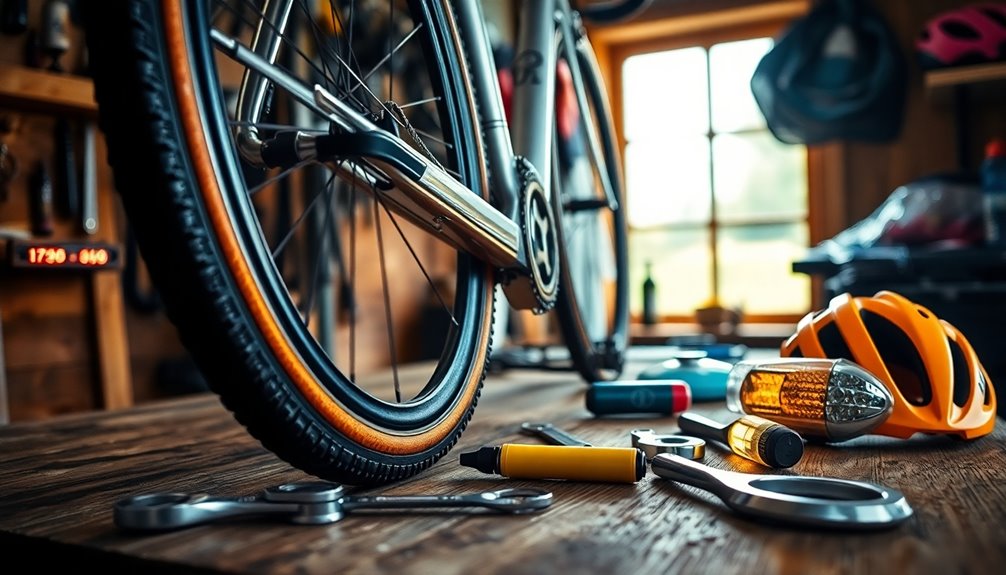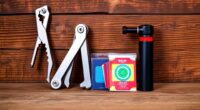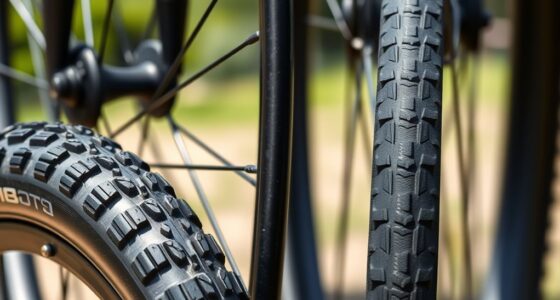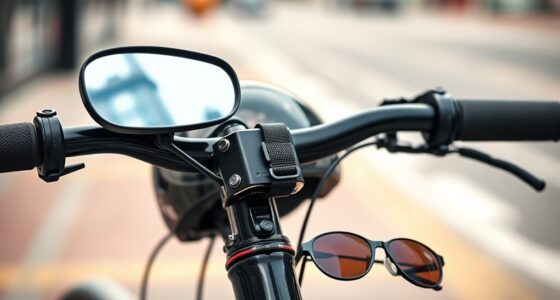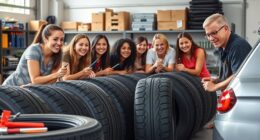Maintaining your bike is essential for a smooth ride and safety. Start with the ABC check: air pressure, brakes, and chain condition. Invest in a few important tools like a multi-tool and quality pump. Clean and lubricate your bike regularly to prevent wear. It's also important to know how to fix a flat tire. Finally, don't forget critical accessories like a helmet and lights. You'll discover even more tips to enhance your biking experience.
Key Takeaways
- Regularly perform the ABC bike check: air pressure, brakes, and chain condition to ensure optimal performance and safety.
- Invest in essential tools like a multi-tool, bike pump, and tire levers for effective bike maintenance and repairs.
- Clean and lubricate your bike frequently, especially after wet rides, to protect components and enhance performance.
- Carry essential repair supplies, including a spare inner tube and tire levers, to quickly address flat tires while on the road.
- Equip yourself with safety gear like a helmet, lights, and reflective clothing to ensure visibility and protection during rides.
Importance of Regular Bike Maintenance
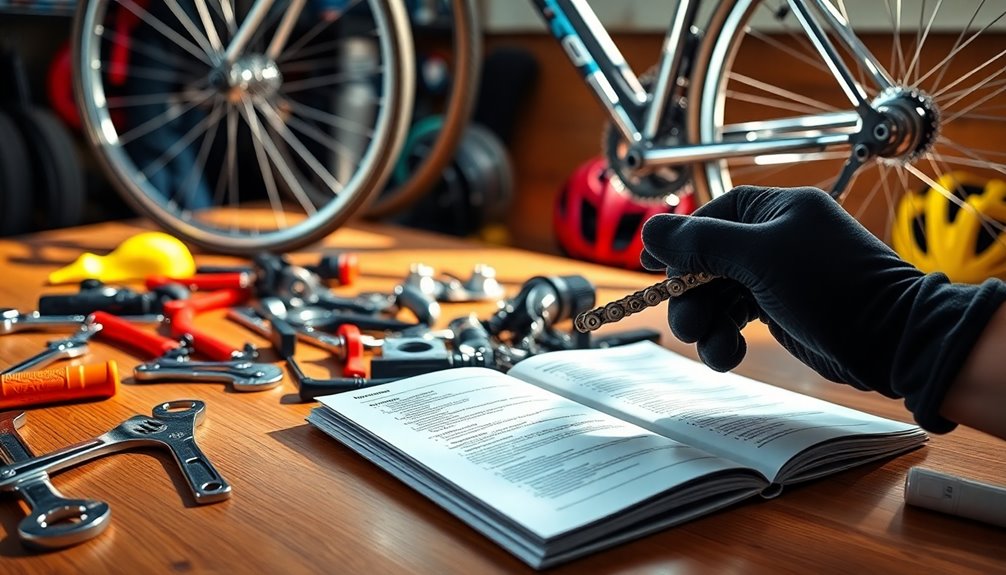
When you prioritize regular bike maintenance, you not only extend the lifespan of your components but also enhance your overall riding experience.
Essential bike maintenance is key to keeping your bike running smoothly. By following simple bike maintenance tips, like checking tire pressure and cleaning your drivetrain, you can prevent dirt and grime from causing wear and tear. This routine care helps avoid costly bike repairs down the road.
Plus, you'll enjoy safer rides, especially on long or challenging routes. Remember to maintain your bike before every ride—this proactive approach can save you money by minimizing the risk of mechanical failures. Additionally, understanding essential gear for bike maintenance can further enhance your preparedness for any ride.
Investing time in these practices guarantees you're ready to hit the road with confidence and comfort.
The ABC Bike Check: Air, Brakes, Chain
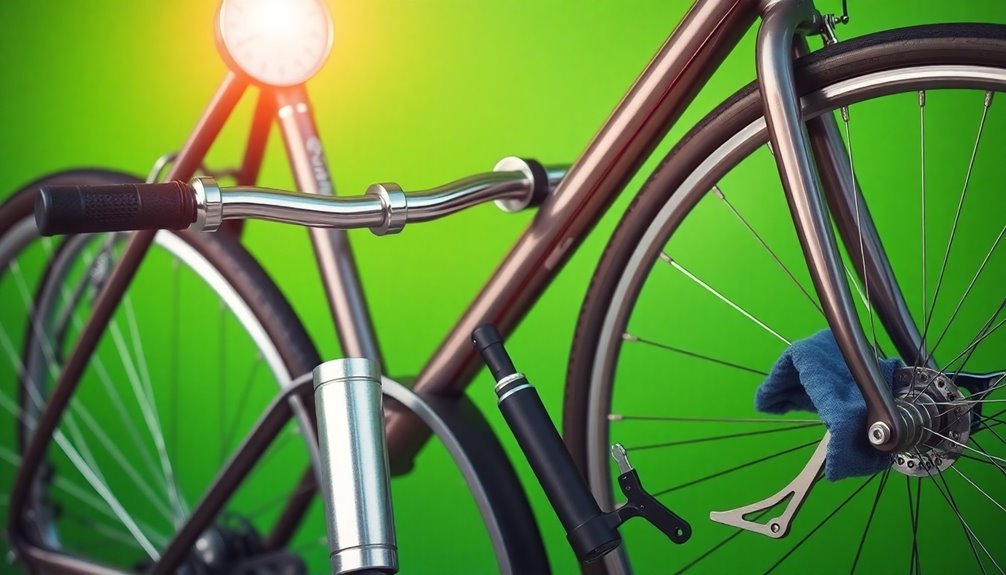
A quick ABC Bike Check can make all the difference in your ride.
Start by checking the air pressure in your tires; for ideal safety, make sure it's within the recommended PSI found on the tire sidewall.
Next, inspect your brakes. Make sure the brake pads are engaging smoothly and that cables are free of fraying. This guarantees reliable braking performance.
Finally, check the chain for smooth movement and adequate lubrication. A squeaky or dry chain is a sign you need to apply lubrication. Regularly checking your chain for smooth movement will help maintain optimal drivetrain efficiency.
By incorporating these checks into your pre-ride routine, you not only enhance your bike performance but also extend its longevity.
Essential Tools for Bike Care

When it comes to bike care, having the right tools makes all the difference.
You'll want to equip yourself with must-have tools like a multi-tool, tire levers, and a good floor pump.
These essentials not only keep your bike in top shape but also guarantee you're ready for any situation on the road.
Must-Have Tools
To keep your bike in top shape, having the right tools on hand is vital for any cyclist.
A reliable multi-tool is a must-have for basic adjustments and repairs, featuring various hex keys and a chain breaker for on-the-go fixes.
A quality bike pump, like a track pump for home and a mini-pump for rides, guarantees you maintain proper tire pressure easily.
Don't forget tire levers; they make changing tires quick and efficient without damaging the rim.
A puncture repair kit, complete with patches and adhesive, allows for swift fixes during rides.
Finally, a set of good-quality hex keys and a torque wrench is important for making precise adjustments to your bike's components, ensuring peak performance and safety.
Maintenance Essentials
Having the right maintenance essentials can make all the difference in keeping your bike running smoothly and safely.
Start with a multi-tool for basic adjustments; it's perfect for tightening bolts and fixing your brake or derailleur. A quality bike pump is a must to maintain proper tire pressure—opt for a track pump at home and a mini-pump for rides.
Don't forget tire levers and a puncture repair kit; these let you handle flat repairs easily. A set of hex keys is fundamental for adjusting components, ensuring a safe fit.
Finally, include a portable chain tool in your repair kit for quick chain cleaning or repairs. Investing in these tools saves you time and money in the long run.
Cleaning and Lubricating Your Bike
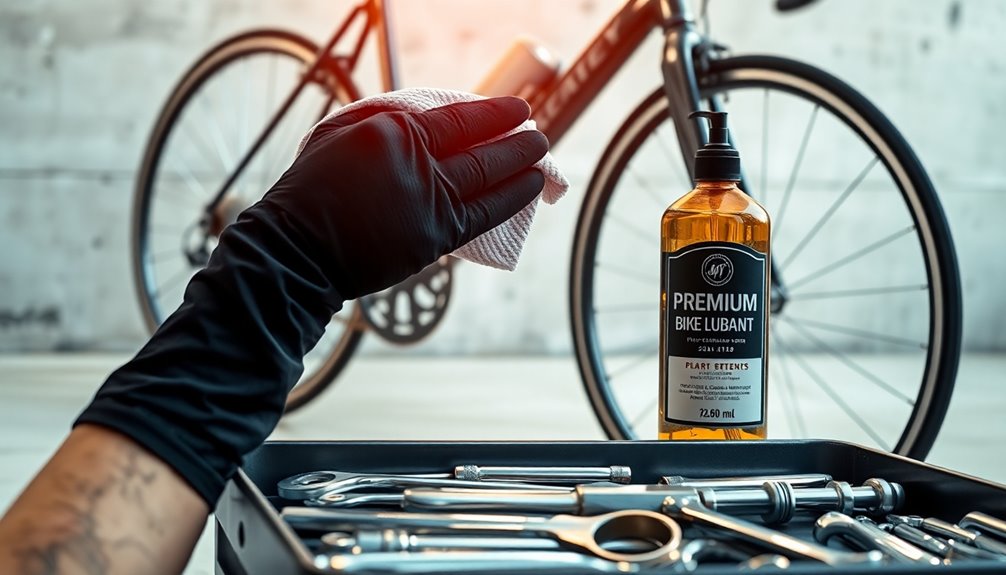
A clean and well-lubricated bike not only looks great but also performs better and lasts longer. Regular cleaning and lubricating protect your bike from wear and corrosion, extending its lifespan.
Here are three key maintenance tips:
- Use a bike-specific degreaser to clean the drivetrain, focusing on the chain, brake, and derailleur cables.
- Apply chain lubricant only when the chain's squeaky or dry, wiping off any excess to prevent dirt buildup.
- After wet rides or every few weeks in dry conditions, thoroughly clean your bike to remove grime and dry it completely to prevent rust.
Establish a maintenance schedule tailored to your riding conditions, as consistent care can greatly reduce the likelihood of costly repairs.
Learning How to Fix a Flat Tire
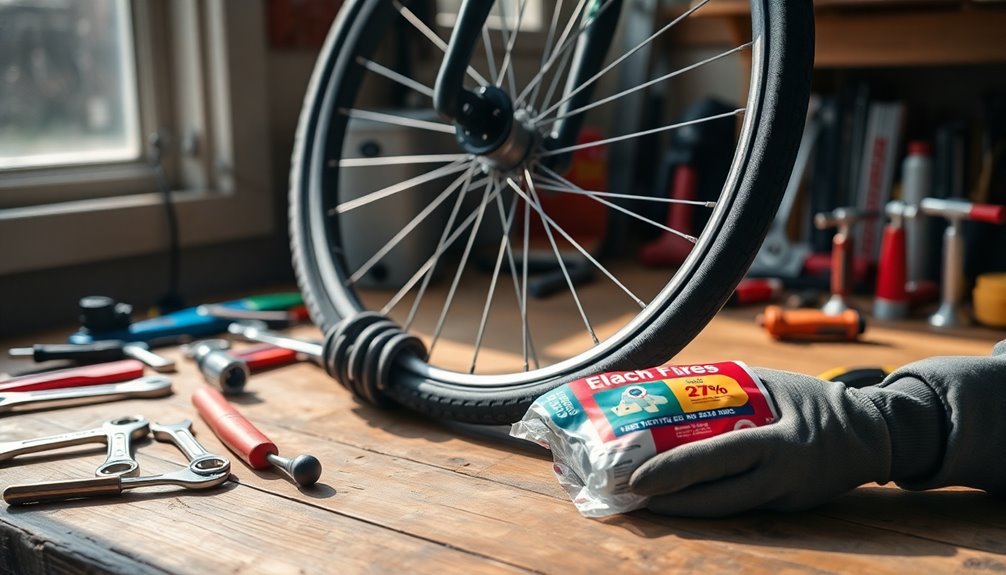
When you're out riding, a flat tire can really throw a wrench in your plans, so it's vital to be prepared.
Always carry essential repair supplies like a spare inner tube and tire levers, and make sure you know how to use them.
With a step-by-step repair guide, you'll be ready to tackle any flat tire situation with confidence.
Essential Repair Supplies
To guarantee you're always prepared for a flat tire, it's crucial to carry essential repair supplies with you on your rides. Familiarize yourself with your bike's tires, as this affects your repair approach.
Here are three must-have items:
- Spare inner tube – This allows for quick replacements.
- Tire levers – They're necessary for removing the tire from the rim.
- CO2 cartridges – These help inflate your tire quickly post-repair.
Practice at home to build your confidence and efficiency when a flat tire strikes on the road.
If you're unsure about the repair process, consider watching instructional videos or visiting your local bike shop for guidance.
With these supplies, you'll be well-equipped to tackle any flat tire situation!
Step-by-Step Repair Guide
Fixing a flat tire can be straightforward if you follow the right steps.
First, gather your essentials: a spare inner tube, tire levers, and a pump or CO2 cartridges.
Start by removing the wheel; if you've got quick-release levers, loosen them properly. Use tire levers to pry the tire off the rim, starting opposite the valve stem.
After removing the flat tube, check the tire for sharp objects.
Insert the new tube by placing the valve in the rim first. Re-seat the tire evenly and inflate it to the recommended PSI.
Finally, reattach the wheel.
As a general rule, do a quick safety check on your bike chain and brake cable every couple of rides to avoid future issues.
Adjusting Brakes and Indexing Gears

Adjusting your bike's brakes and indexing gears is essential for a smooth and safe ride. Start by regularly inspecting your brake pads for wear; replace them when they're less than 1/4 inch thick.
Here are three quick steps to help you out:
- Use the barrel adjuster on the brake caliper to adjust cable tension, ensuring a responsive feel when you pull the brake lever.
- For indexing gears, tweak the cable tension using the barrel adjuster on the rear derailleur, so the chain shifts smoothly between gears.
- Finally, check that the derailleur's jockey wheels align vertically with the cassette in the smallest cog.
Don't forget to take a test ride after adjustments to confirm everything engages correctly!
Recommended Accessories for Cyclists
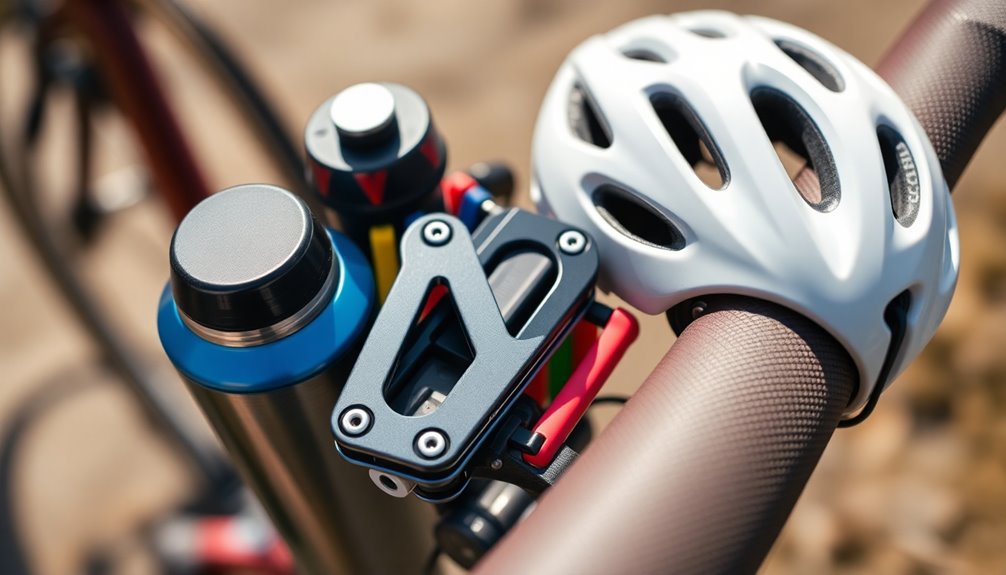
After ensuring your brakes and gears are in top shape, it's time to contemplate the accessories that can enhance your cycling experience. A sturdy bike repair stand makes maintenance easier, allowing you to work comfortably on your bike. Don't forget a quality multi-tool for on-the-go adjustments.
Here's a quick overview of essential accessories:
| Accessory | Purpose |
|---|---|
| Spare Inner Tube | Quick fix for flat tires |
| Mini Pump/CO2 Inflator | Inflate tires to recommended PSI |
| Tire Levers | Simplify tire changes |
| Helmet | Safety against head injuries |
Lastly, remember to lube your chain regularly. Consider joining maintenance classes to learn more tips for keeping your bike in top shape!
Frequently Asked Questions
How Do You Maintain a Bike for Beginners?
To maintain your bike, start with the ABC check—Air, Brakes, Chain—before each ride.
Make sure your tires are properly inflated, brakes are functioning, and the chain is lubricated.
Clean your drivetrain regularly and use a multitool for minor adjustments.
Carry essentials like tire levers, a spare tube, and a mini-pump for emergencies.
Also, familiarize yourself with the correct tire pressure for your bike type to enhance performance and prevent flats.
What Regular Maintenance Should Be Done on a Bike?
To keep your bike in top shape, perform regular maintenance by checking the air in your tires, guaranteeing brakes function properly, and lubricating the chain.
Clean the drivetrain every few weeks to prevent wear. Inspect brake pads for any signs of damage and replace them as needed.
Always monitor tire conditions and keep your bike clean and dry after rides to avoid rust and prolong its lifespan.
Regular checks guarantee a safer, smoother ride.
What's Needed for Bike Maintenance?
What tools do you really need for bike maintenance?
To keep your bike in top shape, you'll want a multi-tool for quick adjustments, a reliable bike pump for tire inflation, and tire levers for easy flat repairs.
Don't forget a puncture repair kit, quality hex keys, and a torque wrench to avoid damaging components.
Regular cleaning supplies, like degreasers and lubricants, are essential too.
Investing in a floor pump with a pressure gauge makes all the difference!
How Do I Service My Bike Myself?
To service your bike yourself, start with the ABC bike check: Air, Brakes, and Chain.
Make sure your tires are properly inflated, brakes work effectively, and the chain is lubricated.
Use a multi-tool for basic adjustments like tightening components and indexing gears.
Regularly clean your bike with appropriate cleaners, focusing on the drivetrain.
Familiarize yourself with essential tools for repairs, and practice fixing common issues to boost your confidence and skills.
Conclusion
Regular bike maintenance not only extends the life of your bike but also enhances your riding experience. Did you know that a well-maintained bike can improve your speed by up to 10%? By following the ABC bike check and keeping essential tools handy, you can tackle repairs with confidence. Plus, investing in quality accessories will make every ride more enjoyable. So, gear up, stay proactive, and enjoy the open road knowing you're taking great care of your trusty bike!
